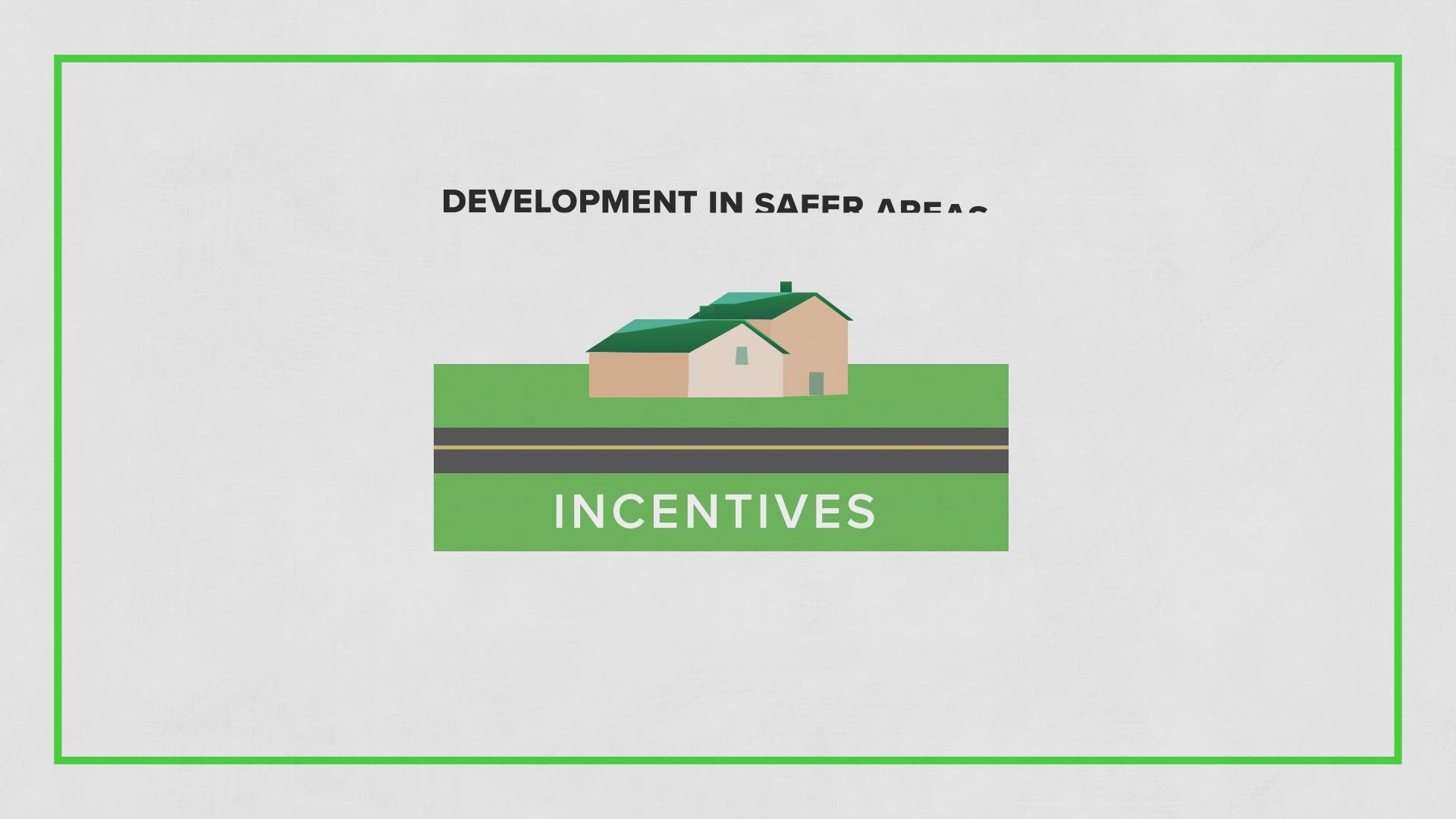As destructive storms cause record flooding in parts of Europe and Asia this summer, experts are warning that climate change is going to create more extreme conditions across the globe, including in the United States. Forty percent of the U.S. population lives in coastal communities, according to NOAA, and data show sea levels are rising faster than ever.
THE QUESTION
Are rising sea levels threatening coastal communities across the United States?
THE SOURCES
- William Sweet, oceanographer with the National Ocean and Atmospheric Administration (NOAA)
- Ben Hamlington, research scientist and team lead of the NASA Sea Level Change Team
- Doug Beaver, chief resilience officer for the City of Norfolk, Virginia
- Ann Phillips, special assistant to the governor of Virginia for Coastal Adaptation and Protection
- Jessica Whitehead, executive director of the Institute for Coastal Adaptation and Resilience at Old Dominion University
- Skip Stiles, executive director of Wetlands Watch
- Karen Speights, homeowner in Norfolk, Virginia
- Mason Andrews, homeowner in Norfolk, Virginia
THE ANSWER
Yes, rising sea levels are threatening coastal areas across the U.S., and some cities will have to spend billions of dollars to protect their communities.
WHAT WE FOUND
Both NOAA and NASA monitor sea levels using tide gauges – a more-than-century-old technology – as well as satellites. Their data show sea levels are rising across the entire U.S. coastline, but most rapidly along the East and Gulf coasts, where the water is rising an inch every five to seven years.
The cause?
“It’s two-part ice melt, one-part thermal expansion,” William Sweet, an oceanographer with NOAA, explained.
Global warming, experts say, is the primary problem, melting ice in Antarctica, Greenland, and mountain glaciers. That is adding water to the ocean. The ocean is also warming up as it absorbs excess heat from greenhouse gasses in the atmosphere, which is causing the water to expand. And on top of that, the land in some coastal areas is slowly sinking.
“What it looks like is an increased frequency of high tide flooding,” Sweet said. “Flooding that used to not occur is occurring on sunny days, and it’s happening more often.”
And with the warming climate, sea level rise is expected to accelerate and cause five to 15 times more flooding in some areas by 2050, according to NOAA.
“When you have that larger sea level, the impacts of a storm… is certainly going to be that much worse in the future,” said Ben Hamlington, who heads NASA’s sea level change team.
A 2019 study by researchers at the University of Southern California found sea level rise could displace 13 million Americans by 2100.
In Norfolk, Virginia, the water is rising faster than anywhere else on the East Coast. The sea has risen close to a foot and a half over the past century and is projected to rise roughly five feet by 2100, though the estimates vary.
Skip Stiles heads the nonprofit Wetlands Watch. He says the effects of rising sea levels can be seen in Norfolk’s Larchmont neighborhood, where streets flood on sunny days and fish can be found swimming in the street.
“Where we’re standing safely… in the coming decades, we’d be standing with waders on in the same spot,” Stiles explained.
During storms, this neighborhood frequently floods, damaging homes and leaving roads impassable for emergency vehicles.
FEMA has paid to elevate around 25 waterfront houses in Larchmont, an upscale neighborhood. Some homeowners have funded that resilience work themselves.
“We’re preserving the lifestyle of folks here, but at some point, it becomes untenable,” Stiles said. “When that is, who knows.”
Norfolk has roughly 10,000 homes in a severe flood hazard area, according to the city.
Mason Andrews bought her historic Norfolk home along the Elizabeth River in 1999. Since then, the flooding has steadily increased, slowly degrading her brick walls and flooding her basement.
“I guess the question is, why the hell am I still here if I know this place probably won’t survive?” Andrews said. “The answer is that it’s my home.”
She had hoped her son would live there long after she’s gone, but now assumes that won’t be possible. She’s already stopped using her basement, saying “the river owns it now.” And she expects the floods will become more frequent.
“I’m going to let the building die with dignity,” she said. “It’s no longer what I consider part of my equity. It’s part of my pleasure.”
The City of Norfolk has launched one of the boldest resilience plans in the U.S. to combat rising sea levels.
“If something is not done, the flooding events will continue,” the city’s chief resilience officer Doug Beaver said. “That’s why we’re trying to stay out in front of the problem.”


They’ve nearly finished an 11-foot berm, two pump stations and a resilience park to protect the Chesterfield Heights neighborhood. The Ohio Creek Watershed Project, as it’s known, was paid for with a $112 million federal grant.
The city plans to spend another $1.8 billion in the coming decades to protect areas that are critical to the city’s economic health. Projects include raising the 11-foot downtown sea wall another foot, elevating roads and improving the city’s stormwater system.
“Norfolk alone won’t be able to carry this burden,” Beaver said of the price tag.
A study from the Center for Climate Integrity found fortifying all U.S. coastlines with sea walls could cost $400 billion by 2040. Virginia alone will cost more than $30 billion.
“The real question is not just can Virginia afford it,” Ann Phillips, the special assistant to the Governor of Virginia for Coastal Adaptation and Protection, said. “Can the federal government afford it? Can state government afford it? Can local government afford it? The answer is probably no, so we’re going to have to make some choices.”
The state of Virginia is nearly finished creating a coastal resilience master plan for the coming decades.
“We can start going after those things that we know are going to be the biggest problems the soonest and not wait until they get worse and worse,” Phillips said. “The challenge is, how do you keep people in your community even with all these circumstances?”
Phillips says the state’s initial projects will be aimed at buying communities time, but eventually, they may look at retreat options.
“All out retreat – moving the entire city somewhere else – is not likely to happen,” she explained. “But moving a neighborhood, a series of houses, a street, a village, those things should be considered. And they will be considered.”
Relocating communities would come at a steep cost, between buyouts, acquiring land, building schools and infrastructure, and other development needs.
Equity is a major concern. Moving forward, Virginia is setting aside 25% of its flood preparedness funds for low-income communities so that no one is left behind.
“We keep calculating the cost of infrastructure to protect,” Jessica Whitehead said. “We haven’t really started to compare that to the costs of retreat, which is absolutely not free.”
Whitehead runs the Institute for Coastal Adaptation and Resilience at Old Dominion University. They’re now studying potential solutions for Norfolk and the greater Hampton Roads community, but that work has just begun.
“That kind of planning is something that takes a lot more conversation,” Whitehead said. “For us to pull it off in 50 to 70 years, we need to start having these arguments now.”
Retreat is not the focus of the work in Norfolk, where the city has laid out a comprehensive resilience plan called Vision 2100.
“There will be places where we think that managed retreat will be the right solution,” Norfolk chief resilience officer Doug Beaver said. “There will be areas that we think elevating homes will be the right solution. And there will be places where we think projects like [the Ohio Creek Watershed] will be the right solution.”
FEMA and the city have only bought out and demolished three Norfolk homes so far – federal funds paid for it.
There are nearly 1,000 Norfolk homes on FEMA’s list of severe repetitive loss properties, having filed multiple claims for flood damage. Karen Speights’ house is one of them.
Speights lives along the Elizabeth River in the home where she grew up. She takes care of her 93-year-old mother. She’s used to nuisance flooding around the property when it rains, but it’s gotten far worse throughout her lifetime.
They’ve suffered three damaging floods in recent years. Speights now pays $400 per month in flood insurance.
“It’s very difficult,” she said. “I could not sustain that amount.”
The only way to drive down the cost of insurance is to remodel so the home is more resilient, but that comes with its own costs. Speights considered selling the house instead.
“But the property value has already gone down,” she said. “What would I sell it for?”
So, she just took out a $104,000 loan to fortify her house instead. Once the project is done, her insurance costs should go down. She says she just needs the home to survive her lifetime.
“I believe, with the work that I’m doing, I can be here for 30 years,” Speights said.
Speights may be a good fit for a new program in Norfolk, spearheaded by Wetlands Watch, that aims to help homeowners with vulnerable properties. It offers incentives to developers who want to build in safer areas if they buy out vulnerable homes and put the land in a conservation easement. The homeowner gets paid but can stay in the house until it floods, or the water level gets dangerously close. Then, the home would get demolished.
“I can tell you people who have this situation,” Wetlands Watch executive director Skip Stiles said. “If somebody comes along and offers you some cash money, so you can get out of your house, you’ll take it.”
But the City of Norfolk stresses there are no plans to flee the waterfront. They say resilience work like the Ohio Creek Watershed Project may keep them afloat long enough for scientists and society to solve the issue of rising levels permanently.
“This project will last this community 80 to 100 years,” Beaver said. “So we would hope… that we will get to a tipping point of that curve not continuing to rise.”



